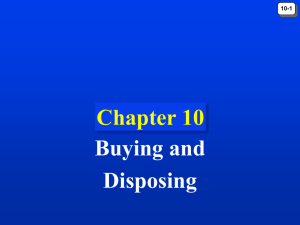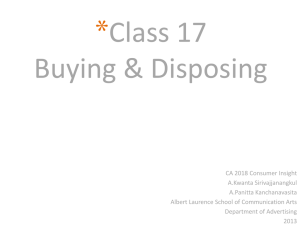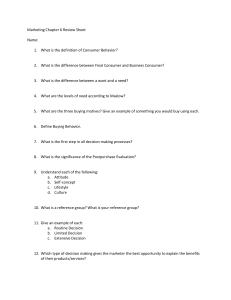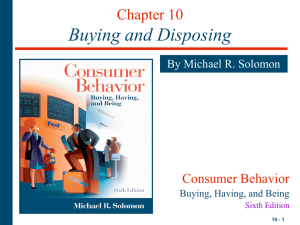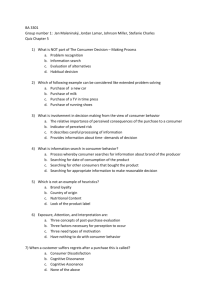MKT 342 Chap 9 Key - Cal State LA
advertisement
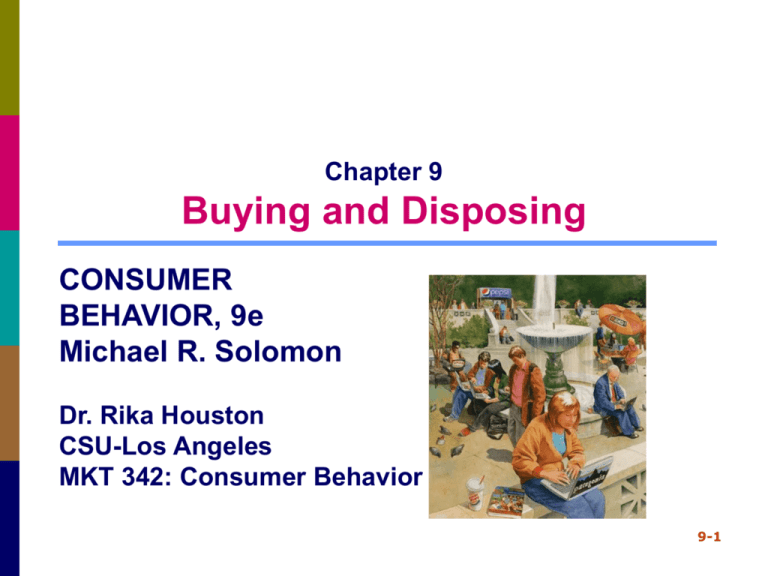
Chapter 9 Buying and Disposing CONSUMER BEHAVIOR, 9e Michael R. Solomon Dr. Rika Houston CSU-Los Angeles MKT 342: Consumer Behavior 9-1 Figure 9.1 Issues Related to Purchase and Postpurchase Activities • A consumer’s choices are affected by many personal factors…and the sale doesn’t end at the time of purchase 9-2 Situational Influences • Our purchase choices are heavily influenced by the situation • Example: ad for business clothing • Example: restaurant choice for couple versus family 9-3 Social and Physical Surroundings • Affect a consumer’s motives for product usage and product evaluation • Décor, odors, temperature • Type and number of co-consumers • Type of patrons affects our perceptions • Crowds = high arousal level & intense experience 9-4 Temporal Factors: Economic Time Timestyle Time Poverty “Time is Money” 9-5 Temporal Factors: Psychological Time Social Temporal Orientation Planning Orientation Polychronic 9-6 Temporal Factors: The Experience of Time • Culture and the experience of time • Linear time (“Western”) • Circular/cyclic time (“Eastern”) • Queuing theory • Waiting for product = good quality • Too much waiting = negative feelings 9-7 Figure 9.3 The Shopping Experience: Dimensions of Emotional States (Mood) 9-8 Reasons for Shopping • Social experiences • Sharing of common interests • Interpersonal attraction • Instant status • The thrill of the hunt 9-9 E-Commerce: Clicks versus Bricks • Benefits: good customer service, more options, more convenient • Limitations: lack of security, fraud, actual shopping experience, shipping charges 9-10 Retailing as Theater • Landscape themes • Marketscape themes • Cyberspace themes • Mindscape themes 9-11 Store Image • Store image = personality of the store • Location + merchandise suitability + knowledge/congeniality of sales staff • Other intangible factors: • Interior design • Types of patrons • Return policies • Credit availability 9-12 In-Store Decision Making • Spontaneous shopping • Unplanned buying • Impulse buying • Point-of-purchase (POP) stimuli • Salesperson influence 9-13 Postpurchase Satisfaction • Attitude about a product after purchase • Marketers constantly on lookout for sources of consumer dissatisfaction 9-14 Quality Is What We Expect It to Be • Expectancy Disconfirmation Model • Marketers must manage expectations • Don’t overpromise • When product fails, reassure customers with honesty 9-15 Acting on Dissatisfaction • Voice response • Private response • Third-party response 9-16 Product Disposal • Strong product attachment • painful disposal process • Ease of product disposal • now a key product attribute • Disposal options 9-17 Divesting of Unwanted Items Iconic Transfer Ritual Transition Place Ritual Ritual Cleansing 9-18 Chapter 9: Buying & Disposing Key Concepts • Antecedents, purchase, and postpurchase activities & • • • • • • • • • • • • • influences Situational influences Social and physical surroundings Temporal factors Mood (emotional states) Clicks versus Bricks Retailing as theater Store image In-store decision making Spontaneous shopping Postpurchase satisfaction Acting on dissatisfaction Product disposal Divesting of unwanted items 9-19
